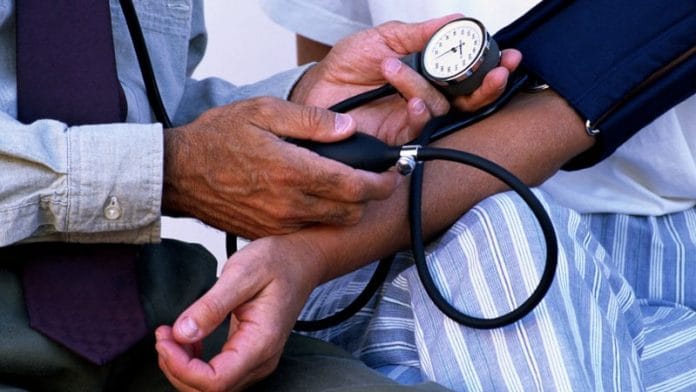New Delhi: One in every five Indian women and one out of four men suffer from hypertension but when it comes to treatment, only 7 per cent women and 6 per cent men who have been diagnosed with high blood pressure are on medication, the National Family Health Survey 5 (NFHS-5) revealed.
The survey also found that 33 per cent of women and 46 per cent men have never got their blood pressures measured.
Undiagnosed/untreated blood pressure can lead to damage to the heart including a contusion (called cardiomegaly) when the heart increases in size because of high diastolic (lower) blood pressure.
The national report based on NFHS-5 data, released last week, also showed that cancer screening coverage remains poor in the country — only 1.2 per cent of women had a cervical examination, 0.6 per cent underwent breast examination and 0.7 per cent took an oral cavity test.
The poor figures come despite the launch of the National Programme for Prevention and Control of Cancer, Diabetes, Cardiovascular Diseases and Stroke twelve years ago in 2010.
This was the first time the hypertension survey was done by lowering the cut-off age to 15 years instead of 18.
NFHS-5 estimated that 21 per cent of females over 15 years have hypertension as opposed to 24 per cent of males in the same age group.
“Twelve per cent of women and 9 per cent of men say that on two or more occasions they were told by a doctor or health professional that they have hypertension or high blood pressure. However, among diagnosed hypertensives only 7 per cent of women and 6 per cent of men are currently taking medicine to lower their blood pressure,” the report stated.
The prevalence of hypertension is higher among Sikhs (37 per cent for men and 31 per cent for women), Jains (30 per cent for men and 25 per cent for women), and Christians (29 per cent for men and 26 per cent for women) than for other religions, the government survey found.
Also read: Soon, a national public health observatory for integration & monitoring of schemes
High blood glucose levels
The survey also looked at the incidence of blood glucose levels in Indians and concluded that men had slightly high blood glucose compared to women.
It found: “Six per cent of women age 15 and over have a high blood glucose level (141-160 mg/dl), and an additional 6 per cent have a very high blood glucose level (more than 160 mg/dl) for a total of 12 per cent of women whose blood glucose level exceeds 140 mg/dl.”
“Seven per cent of men aged 15 and over have a high blood glucose level, and an additional 7 per cent have a very high blood glucose level, for a total of 14 per cent,” the report said.
The survey also found that Christian women (18 per cent) and men (17 per cent) tend to have higher blood glucose levels compared to other religious groups. Among the states, the prevalence of high and very high blood glucose (combined) among women ranges from 6 per cent in Ladakh to 21 per cent in Kerala. For men, the prevalence ranges from 7 per cent each in Ladakh and Jammu & Kashmir to 22 per cent in Goa and 24 per cent in Kerala.
Crude death rate
The NFHS-5 fieldwork was conducted in two phases during which information was gathered from 6,36,699 households by reaching out to 7,24,115 women and 1,01,839 men.
In Phase-I, 17 states and 5 Union Territories were covered between 17 June 2019 to 30 January 2020. In the second phase, data were collected from 11 states and 3 UTs from 2 January 2020 to 30 April 2021.
The survey pegged India’s crude death rate (which indicates the number of deaths per 1,000 mid-year population) at 9 deaths per 1,000 population (10 per 1,000 for men and 8 per 1,000 for women).
The crude death rates (CDR) ranged from 5 to 11 deaths per 1,000 across states and UTs in India. The CDR was less than the national average in northeastern, western, and northern states. In Meghalaya, Jammu & Kashmir, Dadra & Nagar Haveli and Daman & Diu, Lakshadweep and Nagaland, the CDR was 5 deaths per 1,000, whereas, in Odisha, Puducherry and Tamil Nadu, the number stood at 11 deaths per 1,000.
Also read: In rebuttal to WHO, Modi govt claimed 99.9% deaths registered. NFHS-5 pegs 2019-21 figure at 71%






